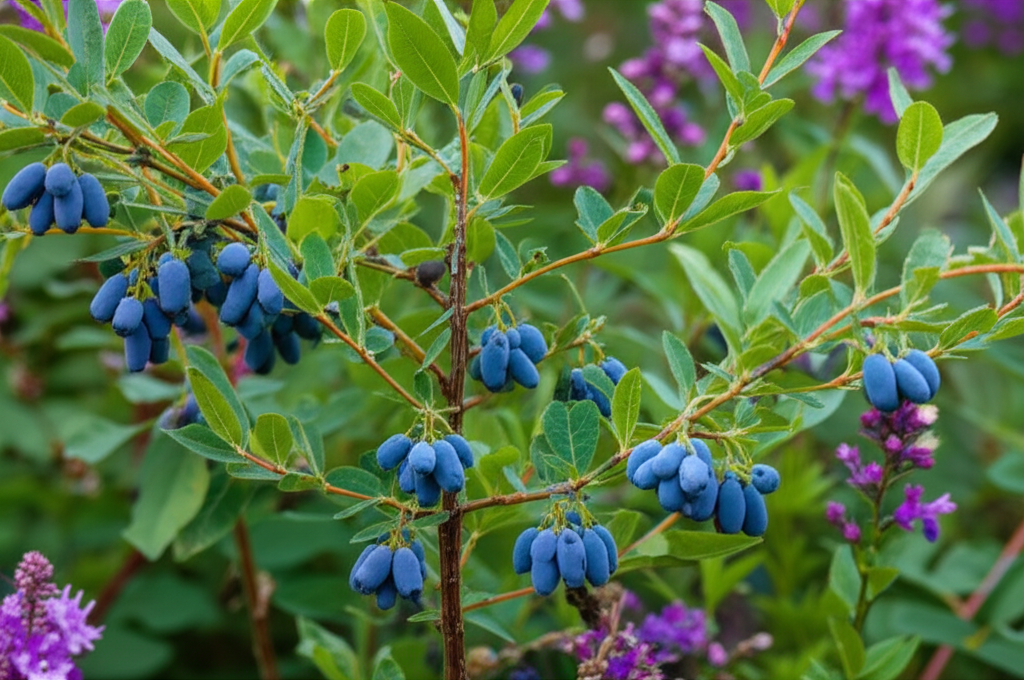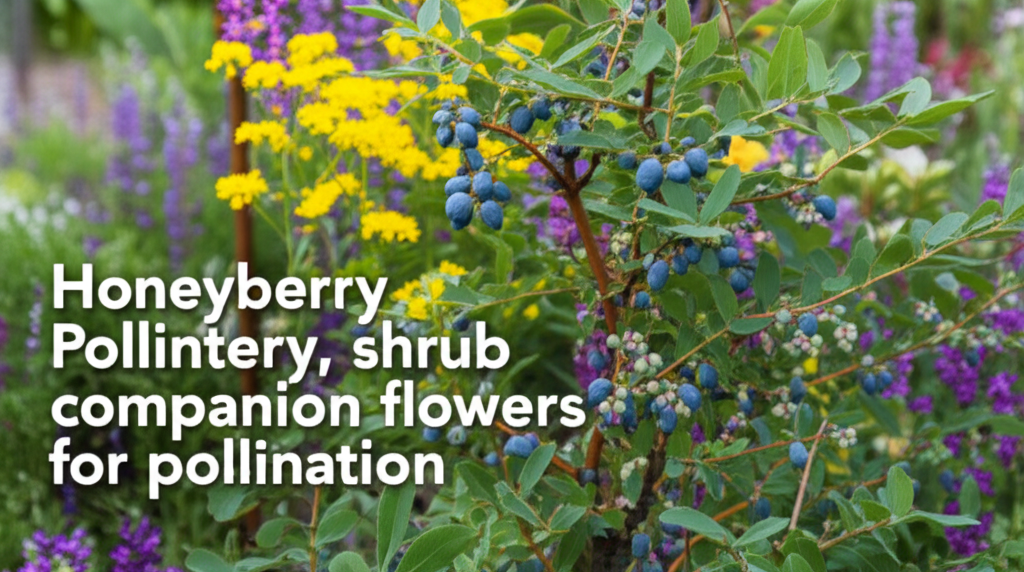The Sweet Synergy: Why Companion Planting Matters for Honeyberries
Honeyberry (also known as Haskap) shrubs are a fantastic addition to any garden, offering early-blooming flowers and delicious, nutrient-rich berries. To maximize your honeyberry harvest and overall plant health, understanding the principles of companion planting is key. Companion planting involves strategically placing different plant species together to create a mutually beneficial environment. This can involve attracting pollinators, deterring pests, improving soil health, and enhancing nutrient uptake. For honeyberries, the most crucial aspect of companion planting revolves around ensuring effective pollination.
While honeyberries are self-pollinating to some extent, their fruit set and berry size are significantly improved when cross-pollinated by another honeyberry variety. However, attracting a broader range of pollinators, including bees and other beneficial insects, can further boost your yields and overall plant vigor. This is where companion flowers come into play. By planting flowers that bloom concurrently with your honeyberries or that attract pollinators during the honeyberry’s flowering period, you create a more vibrant ecosystem that benefits your honeyberry shrubs.
Understanding Honeyberry Pollination Needs

Honeyberries are among the earliest blooming plants in many temperate climates, often flowering in late winter or early spring, sometimes even before the last frosts have disappeared. This early bloom makes them vulnerable to insufficient pollinator activity if other nectar and pollen sources are scarce.
Honeyberries have a unique pollination mechanism. They are entomophilous, meaning they rely on insects for pollination, primarily bees. For successful fruit set, pollen from one honeyberry cultivar needs to be transferred to the flower of a different cultivar. However, the presence of generalist pollinators, even if they aren’t specifically honeyberry pollinators, can still be beneficial. They increase overall pollinator traffic in the garden, indirectly increasing the chances of cross-pollination occurring. Furthermore, these companion flowers can act as a “food base” for pollinators, ensuring their presence in your garden during the critical honeyberry flowering window.
Key Characteristics of Ideal Honeyberry Companion Flowers
When selecting companion flowers for your honeyberries, several factors should be considered to ensure they truly benefit your honeyberry shrubs:
- Bloom Time: The most critical factor is bloom time. Companion flowers should ideally bloom at the same time or slightly before the honeyberries to attract pollinators early.
- Pollinator Attraction: Flowers that are known to attract bees, hoverflies, and other beneficial insects are paramount. Look for species with open, easily accessible flowers that provide abundant nectar and pollen.
- Growth Habit: The companion plant’s size and growth habit should complement the honeyberry shrub without overwhelming it. Low-growing, spreading plants can act as a living mulch, while taller, slender plants can provide vertical interest.
- Soil and Light Requirements: Ideally, companion flowers should share similar preferences for soil type, pH, and sunlight exposure as honeyberries. Most honeyberries thrive in full sun to partial shade and well-drained, slightly acidic soil.
- Pest Deterrence: Some companion plants have natural pest-repelling properties, which can further protect your honeyberry shrubs.
- Aesthetic Appeal: While functionality is key, don’t overlook the visual appeal. A mix of colors and textures can make your garden a more beautiful and enjoyable space.
Top Companion Flower Picks for Honeyberry Pollination
Here are some excellent companion flower choices that align with the needs of honeyberry shrubs:
Early Spring Bloomers (Crucial for Honeyberry Pollination)
These flowers kickstart the pollinator season, ensuring a consistent presence of bees when honeyberries are in bloom.
- Forget-Me-Nots (Myosotis spp.): These delicate blue flowers are among the earliest bloomers. They are magnets for early emerging bees and provide a beautiful carpet of color beneath your honeyberries. They prefer moist, well-drained soil and partial shade.
- Primroses (Primula spp.): Available in a wide array of colors, primroses offer early nectar and pollen. They thrive in shady, moist conditions, making them a good underplanting for honeyberries that receive some afternoon shade.
- Violas and Pansies (Viola spp.): Hardy varieties of violas and pansies can tolerate light frost and bloom in early spring. Their cheerful faces attract small bees and hoverflies. They prefer cooler temperatures and moist soil.
- Creeping Phlox (Phlox subulata): This low-growing, mat-forming phlox blooms prolifically in early to mid-spring with a carpet of pink, purple, or white flowers. It attracts bees and tolerates full sun and well-drained soil, making it a great ground cover for honeyberry beds.
- Lungwort (Pulmonaria spp.): Lungwort offers attractive foliage and bell-shaped flowers that change color as they mature, providing nectar for early bees. It prefers shady, moist environments.
Mid-Spring Bloomers (Sustaining Pollinator Activity)
As honeyberries continue to flower, these plants provide a continuous food source for emerging pollinators.
- Borage (Borago officinalis): This easy-to-grow annual is a powerhouse for bees. Its star-shaped blue flowers are rich in nectar and pollen, and it blooms from spring until frost. Borage self-seeds readily and prefers full sun.
- Comfrey (Symphytum officinale): While often grown for its medicinal properties and as a compost activator, comfrey also produces abundant nectar-rich flowers that are a favorite of bumblebees. It’s a robust perennial that thrives in full sun to partial shade.
- Bleeding Hearts (Dicentra spectabilis): These classic shade garden plants offer unique, heart-shaped flowers in spring, attracting bees. They prefer moist, well-drained soil and partial to full shade.
- Columbine (Aquilegia spp.): Known for their intricate, spurred flowers, columbines attract a variety of pollinators, including bees and hummingbirds. They prefer partial shade and well-drained soil.
- Virginia Bluebells (Mertensia virginica): Native to woodland settings, these lovely blue, bell-shaped flowers are a favorite of early spring bees. They thrive in moist, shady conditions and go dormant in summer.
Late Spring/Early Summer Bloomers (Benefiting Young Berry Development)
While honeyberry fruits develop, these plants can support pollinators involved in the later stages of honeyberry fruiting and attract beneficial insects that might prey on potential pests.
- Catmint (Nepeta spp.): Varieties like ‘Walker’s Low’ are long-blooming, drought-tolerant, and highly attractive to bees. They prefer full sun and well-drained soil.
- Lavender (Lavandula spp.): Famous for its fragrance and ability to attract bees and other pollinators, lavender thrives in full sun and well-drained soil.
- Coneflower (Echinacea spp.): These daisy-like flowers are a favorite of butterflies and bees. They prefer full sun and are relatively drought-tolerant once established.
- Salvia (Salvia spp.): Many varieties of Salvia, such as woodland sage, are excellent for attracting bees and have a long bloom period. They generally prefer full sun and well-drained soil.
Key Facts and Comparison of Companion Flower Types
This table provides a quick overview of some of the best companion flower options for your honeyberry shrubs, highlighting their bloom time, pollinator preference, and ideal growing conditions.
| Companion Flower | Primary Bloom Time | Attracts Primarily | Soil Preference | Sun Exposure | Growth Habit |
|---|---|---|---|---|---|
| Forget-Me-Nots | Very Early Spring | Small Bees | Moist, Well-Drained | Partial Shade | Low-growing, Spreading |
| Borage | Spring to Fall | Bees (especially bumblebees) | Well-Drained | Full Sun | Upright, Self-seeding Annual |
| Creeping Phlox | Early to Mid-Spring | Bees | Well-Drained | Full Sun | Low-growing, Mat-forming |
| Comfrey | Late Spring to Summer | Bumblebees | Moist, Rich | Full Sun to Partial Shade | Tall, Upright Perennial |
| Catmint | Late Spring to Summer | Bees | Well-Drained, Drought-Tolerant | Full Sun | Mounding, Bushy |
| Lavender | Late Spring to Summer | Bees, Butterflies | Well-Drained, Sandy | Full Sun | Mounding, Bushy |
Implementing Companion Planting: Steps and Considerations
Successfully integrating companion flowers into your honeyberry patch involves a few key steps and considerations to maximize benefits and minimize potential issues.
| Step/Consideration | Description | Pros | Cons |
|---|---|---|---|
| Site Selection | Choose a location that receives adequate sunlight (full sun to partial shade) for your honeyberries and companion flowers. Ensure good drainage. | Optimizes growth for both plant types. | Limited options if ideal conditions are not available. |
| Soil Preparation | Amend the soil with compost to improve fertility and drainage. Ensure the soil pH is slightly acidic, suitable for honeyberries. | Promotes healthy root development and nutrient availability. | Requires effort and potential cost for amendments. |
| Plant Spacing | Plant companion flowers around the base of honeyberry shrubs, ensuring they do not compete aggressively for water and nutrients. Consider their mature size. | Prevents overcrowding and resource competition. | Requires careful planning to avoid hindering honeyberry growth. |
| Variety Selection | Choose companion flowers with overlapping bloom times and compatible growing needs. | Maximizes pollinator attraction during honeyberry flowering. | Research is required to identify suitable pairings. |
| Mulching | Apply a layer of organic mulch (e.g., wood chips, straw) around the base of both honeyberries and companion plants to retain moisture, suppress weeds, and regulate soil temperature. | Conserves water, reduces weeding, improves soil health. | Can harbor slugs/snails if applied too thickly around stems. |
| Watering Needs | Ensure consistent watering, especially during dry periods, to support both honeyberry and companion flower health. | Crucial for plant survival and productivity. | May require more frequent watering in hot climates or sandy soils. |
Beyond Pollination: Additional Benefits of Companion Flowers
While enhancing pollination is the primary goal, companion flowers offer a cascade of other benefits for your honeyberry shrubs:
- Pest Deterrence: Certain aromatic herbs and flowers can repel common pests that might target honeyberries. For instance, planting mint (contained in pots to prevent invasiveness) or chives nearby can deter aphids.
- Attracting Beneficial Insects: Flowers like dill, fennel, and yarrow attract predatory insects such as ladybugs and lacewings, which feed on pests like aphids and spider mites.
- Improving Soil Health: Leguminous companion plants, like clover, can fix nitrogen in the soil, making it available to honeyberry shrubs. Deep-rooted plants can help break up compacted soil.
- Weed Suppression: Low-growing, groundcover-style companion flowers can help suppress weed growth by shading the soil, reducing competition for water and nutrients.
- Aesthetic Enhancement: The vibrant colors and textures of companion flowers create a visually appealing garden, turning your productive patch into a beautiful landscape.
Considerations for Different Honeyberry Varieties
While most honeyberry varieties share similar pollination needs, subtle differences in bloom time or vigor might exist between cultivars. For instance, early-blooming varieties will benefit most from the earliest spring flowers. Conversely, mid-season bloomers will benefit from plants that continue to flower as the season progresses. Always check the specific bloom times for your particular honeyberry cultivars to make the most informed companion planting decisions.
Conclusion: Cultivating a Thriving Honeyberry Ecosystem
By thoughtfully selecting and integrating companion flowers, you can significantly enhance the health, productivity, and resilience of your honeyberry shrubs. These blooming partners not only attract essential pollinators during the critical early spring flowering period but also contribute to a more balanced and robust garden ecosystem. From delicate forget-me-nots to robust borage, each flower plays a vital role in supporting your honeyberry harvest. Embrace the principles of companion planting and watch your honeyberry patch flourish!


